3. Disney won’t stop designing attractions for 8-year-old girls
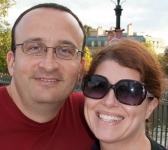
Len Testa, president of Touring Plans:
What needs to happen to keep Walt Disney World creatively competitive? Stop designing rides for 8-year old girls.
 The Disney Princesses. Image © Disney.
The Disney Princesses. Image © Disney.
As Robert said, Disney’s big enough that they can remain competitive for the next 10 years, even if all they did was the occasional themed update to existing rides. That’s largely due to Walt’s genius in the 1950s and 1960s, and Eisner’s belle époque building spree from 1984 to 2005. Because of those two men, Disney World can do very little and still have more guests than Universal and SeaWorld combined.
But can Disney compete on creativity? Let's put that another way: is there anything in Disney’s recent history that indicates they can build the kind of large-scale, detailed, appeals-to-all-ages project like Universal’s Diagon Alley?
Not really. Leaving aside all of New Fantasyland, which was built to address capacity concerns in the Magic Kingdom, what was the last big attraction Disney opened that wasn’t specifically targeted to young girls? Kim Possible World Showcase Adventure in 2009? A minor attraction. Toy Story Mania in 2008? It’s a fun ride, but not in the same league as Harry Potter.
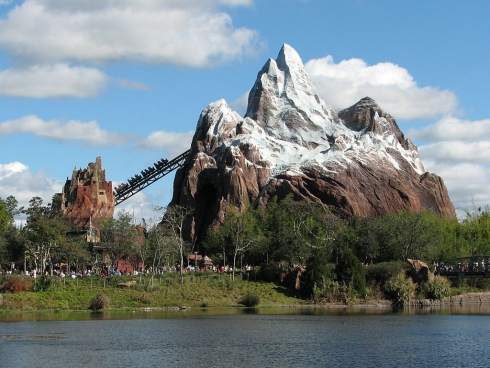 Expedition Everest. Image © Wikimedia Commons.
Expedition Everest. Image © Wikimedia Commons.
I think you have to go back almost a decade, to 2005, to find examples. In that year, Disney opened Soarin’, Expedition Everest, and Lights! Motors! Action!. (As Meatloaf said, two out of three ain’t bad.) Both Soarin’ and Everest are enormously popular headliner attractions that re-energized their parks. Neither has a princess or a fairy.
In fact, if you look at Disney’s most popular attractions – Space Mountain,
Splash Mountain, Big Thunder Mountain, Haunted Mansion, Pirates of the Caribbean, Spaceship Earth, Soarin’, Test Track, The American Adventure, Rock ‘n Roller Coaster, Tower of Terror, Toy Story Mania, Kilimanjaro Safaris, Expedition Everest – not a single attraction has a princess or fairy in it, and none had small children in mind as their primary audience.
More importantly, of those 14 attractions, only Toy Story Mania and Tower of Terror were based on existing franchises. Clearly, Disney’s best attractions come from the minds of Disney’s Imagineers, drawing on a blank canvas and not required to build a ride based on marketing studies or movie franchise tie-ins.
So that’s what Disney has to do to remain creatively competitive. Keep the marketing people out of Imagineering’s offices. Don’t require a ride to have a marketing or character tie-in to get built. Spend some money.
And for the love of Walt, think big.
4. Disney is focusing on making more money out of its existing customers rather than attracting new ones

Nick Sim, Theme Park Tourist editor-in-chief:
As Jim and Robert have rightly pointed out, Disney doesn't need to do anything to stay competitive in the Orlando theme park market.
A lot has been written about Universal Orlando's aggressive expansion, and it is indeed a very exciting time for the resort. But as Comcast's CEO, Brian Roberts, said back in January, "we have the low market share and only one way to go." It makes sense for Universal to keep throwing money at new attractions and hotels, because it still has so much room for growth (figuratively… in physical terms, it is running low on space).
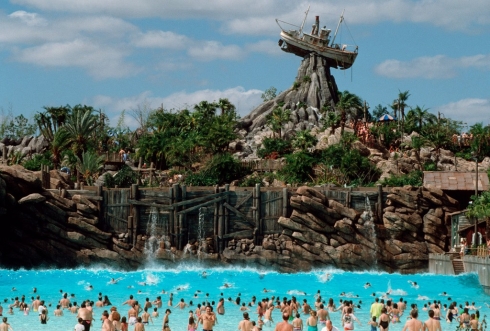 Typhoon Lagoon, a product of Eisner's building spree. Image © Disney.
Typhoon Lagoon, a product of Eisner's building spree. Image © Disney.
In fact, Universal is in a similar situation to Disney back in the 1980s, when Eisner and Wells saw that Walt Disney World was being underexploited and (eventually) opened a huge number of hotels, two entire new theme parks, and two water parks. Nowadays, Disney just won't see the same level of return on its investment, which is probably why we're still waiting on the mythical fifth gate.
Disney can afford to do nothing if it chooses to because it has enormous brand loyalty that spans multiple generations (just try posting anything critical about the company online to test this theory… but remember to wear protective clothing). While SeaWorld, Universal, and Legoland might still be popular, they simply don't have the same brand cachet. Even Harry Potter can't touch Mickey.
Of course, Marc's question was about what Disney needs to do to stay creatively competitive… and it's arguable that they've been lagging behind Universal on that front for at least a decade. Aside from some impressive audio-animatronics, there's not really anything in New Fantasyland that we haven't seen before.
I think the problem is a basic lack of creative ambition. Back in the early days of Disneyland and Walt Disney World, Disney attractions were not just ground-breaking – they were trying to actually change the world (the monorail, the PeopleMover, etc.). As Len points out, many of the great Disney attractions were not based on Disney movies at all, but on new ideas from the company's Imagineers.
Then there was the revival in the 1980s and early 1990s, when Disney's studios were in the doldrums and the company was forced to bring in ideas from outside. The result? Star Tours, the Twilight Zone Tower of Terror, and Indiana Jones Adventure.
So what could Disney do to regain its creative lead? Give the Imagineers the freedom to come up with their own original concepts – ones that are not tied to the latest movie release. And allow them to cherry-pick the best ideas from other sources – something which, hopefully, they are doing with Pandora: The World of Avatar.
Realistically, though, I think Jim is right – Disney is going to focus on making more money out of its existing customers, rather than attracting new ones. If Universal ever becomes a serious threat, it will open up its purse strings and spend its way back to prominence.
But that situation is a looooooong way off.
5. Disney’s size: Its biggest asset, but also its biggest weakness

Lance Hart, editor-in-chief of Screamscape:
As the others have already stated, Disney is already the 500-pound gorilla in the marketplace, having built themselves up in size to dwarf everyone else years ago. As such, it is true that they can pretty much coast along for at least the next decade, maybe two, making only minor course corrections here and there before the situation would turn dire. Parents will still take their children to Disney, because their own parents took them when they were children.
But time can change all things, and I think Universal is undertaking a wise strategy here against Disney. They are investing heavily now and creating new experiences and attractions for today’s youth that you can’t find anywhere else, and they will respond when they have children of their own in the future by taking them to relive these same experiences. Sure, they will end up going to Disney still… but you can also be damn sure they will take them to Universal’s Wizarding World to get their first taste of Butterbeer, as well.
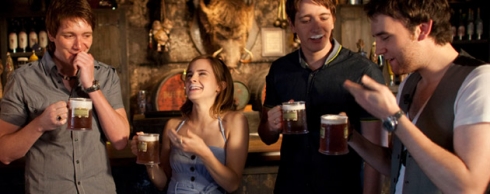 The Harry Potter actors enjoy some Butterbeer. Image © Universal.
The Harry Potter actors enjoy some Butterbeer. Image © Universal.
If Universal continues down this path, I think we really will start to see them slowly start to eat away at Disney’s dominance each and every year. Disney will fight back, of course, with the occasional big project like Avatar, but I think Disney’s biggest asset – pure size – can also their biggest weakness, because it takes a lot of time and energy to turn a ship that size around. Universal has proven to be far more nimble than I think anyone suspected, especially in regards to how fast they were able to bring Transformers to life in Orlando.
We’ve also be focusing our comments on the Walt Disney World market, but it is also worth mentioning that Universal is bringing the Wizarding World of Harry Potter to the California market, as well, where we could see the dynamic of the SoCal marketplace start to change, as well. Of course, the Disneyland Resort seems to have been far savvier to understand and respond to what Universal has done in Florida with the creation of Cars Land in California Adventure, which also has brought not only a highly-themed, immersive environment, but also themed food items to the mix.
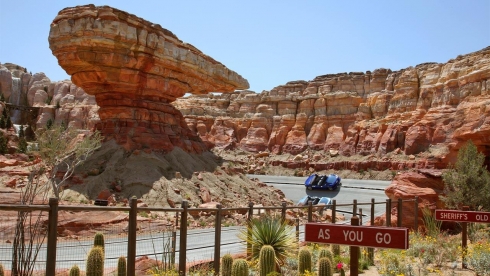 The most magical place on Earth: Cars Land. Image © Disney.
The most magical place on Earth: Cars Land. Image © Disney.
So if Disney could learn something from their very hungry competition, perhaps the best lesson would be to try and act more quickly. The general public has been very quick to criticize the slowness in which New Fantasyland was built, as well as how long it is taking for Avatar. Going hand-in-hand with this, Disney can also be painfully slow to capitalize in big ways on the success of their latest cinematic hits, like Frozen and the Marvel Cinematic Universe, and now seems to have reined in rumored plans to expand the Star Wars universe into the parks, as well.
Also, as other have stated, they need to not be afraid to let Imagineering’s imagination run wild to create their own custom-themed attractions. We’ve seen some of the most impressive work from Imagineering come to Disney’s overseas parks with custom attractions and themes built into Tokyo DisneySea and Hong Kong Disneyland, and I’m sure we’ll see even more at Shanghai Disneyland, as well.
Add new comment